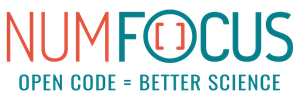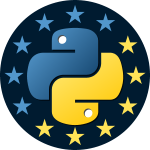In recent years, data science has become a very important part of the Python's eco-system. EuroPython has been dedicated to showcasing Python's use in data science for many years. This year, we have reserved two all day tracks to this topic and added keynotes and workshops as well.
Data Science Mini-Conference
We are happy to announce a complete data science mini-conference as part of the main EuroPython conference this year.
Many of the talks rely on projects which are funded by NumFocus. Please find more information and the mission of NumFocus supporting Open Source Software below.
We will have two full day tracks featuring 37 full-length talks, 2 keynotes, 9 workshops/training sessions, 2 interactive sessions and 1 poster:
- Keynotes are on Thursday in the Optiver Room
- Talks are between Wednesday and Friday primarily in the Parrot Room
- Interactive sessions take place on Wednesday in Argument-Clinic [Interactive] Room
- Poster is shown on Friday in Argument-Clinic [Posters] Room.
In addition, many other talks touch upon data science. For your convenience, we have listed them all below. For all the other topics, please check out the full lineup of EuroPython 2021!
Keynotes
- Connecting Communities: the Helmholtz Analytics Framework and the making of Heat by Claudia Comito
- Our Universe through Sight, Sound & Touch by Kimberly Arcand
Talks
- A Gentle Introduction To Causal Inference by Eyal Kazin
- Auto-Sklearn: Automated Machine Learning in Python by Matthias Feurer, Katharina Eggensperger
- Automated Machine Learning With Keras by Ondrej Urban
- Big Imagery Data Visualization with Gradient-weighted Class Activation Maps by Thomas Y. Chen
- Build Your First Cyber Forensic Application using Python by Gajendra Deshpande
- Building Brain-Computer Interfaces with Timeflux by Pierre Clisson
- Computational Complexity Theoretical Foundation on How Long Will Program Run by Kautilya Katariya
- Darts: Unifying time series forecasting models from ARIMA to Deep Learning by Gael Grosch, Francesco Lässig
- Data lake: Design for schema evolution by Prakshi Yadav
- Designing Functional Data Pipelines for Reproducibility and Maintainability by Chin Hwee Ong
- Federated Machine Learning with Python by Dhanshree Arora
- From telemetry data to CSVs with Python, Spark and Azure Databricks by Nicolò Giso
- Graph neural networks for information extraction with PyTorch by Augusto Stoffel
- Heartbeats for Hackers by Andreas Klostermann
- High Performance Data Processing with Python, Kafka and Elasticsearch by Harshit Prasad
- How Scientific Computing is advancing the world of Football by Chiin-Rui Tan, Sara Nunnington
- Introducing Asynchronous SQLAlchemy by Sebastiaan Zeeff
- Introduction to Quantum Deep Learning by Abhilash Majumder
- Leveraging Linked Data using Python and SPARQL by Nabanita Roy
- Measuring memory: Python memory profilers and when to use them by Itamar Turner-Trauring
- Powerful tests and reproducible benchmarks with `pytest-cases` by Sylvain Marié
- Production ML Monitoring: Outliers, Drift, Explainers & Statistical Performance by Alejandro Saucedo
- Protecting Your Machine Learning Against Drift: An Introduction by Oliver Cobb
- Python and Flutter application for Colouring and Enhancing Old Photos by Utkarsh Mishra
- Python Data Science with VS Code and Azure by Sid Unnithan, Claudia Regio
- Reproducible and Deployable Data Science with Open-Source Python by Lim H.
- Simple, open, music recommendations by Sam Thursfield
- Sliding into Causal Inference, with Python! by Alon Nir
- Sound Event Detection with Machine Learning by Jon Nordby
- SQLite, an (un) known super ant by María Andrea Vignau
- Streamlit: The Fastest Way to build Data Apps by Steven Kolawole
- The Myth of Neutrality: How AI is widening social divides by Stefanie Stoppel
- Virtual Tourism In Covid Times by Nithish Raghunandanan
- We build a ML pipeline after we deploy by Alyona Galyeva
- Wildfire Modeling in Yosemite National Park by Abraham Coiman
Training sessions
- Activate Your Interest in Coding for Algorithmic Trading by Adam Kasperowicz, Julian Brendl, Gregory Pandechis
- Build a deep learning-powered image search system with Jina + BigTransfer (BiT) by Cristian Mitroi, Maximilian Werk
- Build and deploy PyTorch models with Azure Machine Learning by Henk Boelman
- Building a practical Slack bot with Python & FastAPI by Radoslav Georgiev
- Climate data analysis with xarray and cartopy by Mia Polovina
- Data Analysis with pandas - Workshop by Marco Bonzanini
- Docker for Machine Learning Engineers by Jonathan Fernandes
- Implementing a Neural Network from Scratch by Rodrigo Girão Serrão
- Knowledge graph data modelling with TerminusDB by Cheuk Ho
Poster sessions
Interactive sessions
- Data Ingestion and Big Data by Mauro Pelucchi
- The Pattern: Machine Learning Natural Language Processing meets VR/AR by Alexander Mikhalev, Dvir Dukhan

About NumFocus
The mission of NumFOCUS is to promote open practices in research, data, and scientific computing by serving as a fiscal sponsor for open source projects and organizing community-driven educational programs.
NumFOCUS envisions an inclusive scientific and research community that utilizes actively supported open source software to make impactful discoveries for a better world.
Many known projects are supprted by NumFoucs, just to mention a few: NumPy, Pandas, Matplotlib, Jupyter, SciPy, SymPy, Bokeh, xarray,… The full list.
NumFOCUS is a 501(c)3 public charity in the United States.
